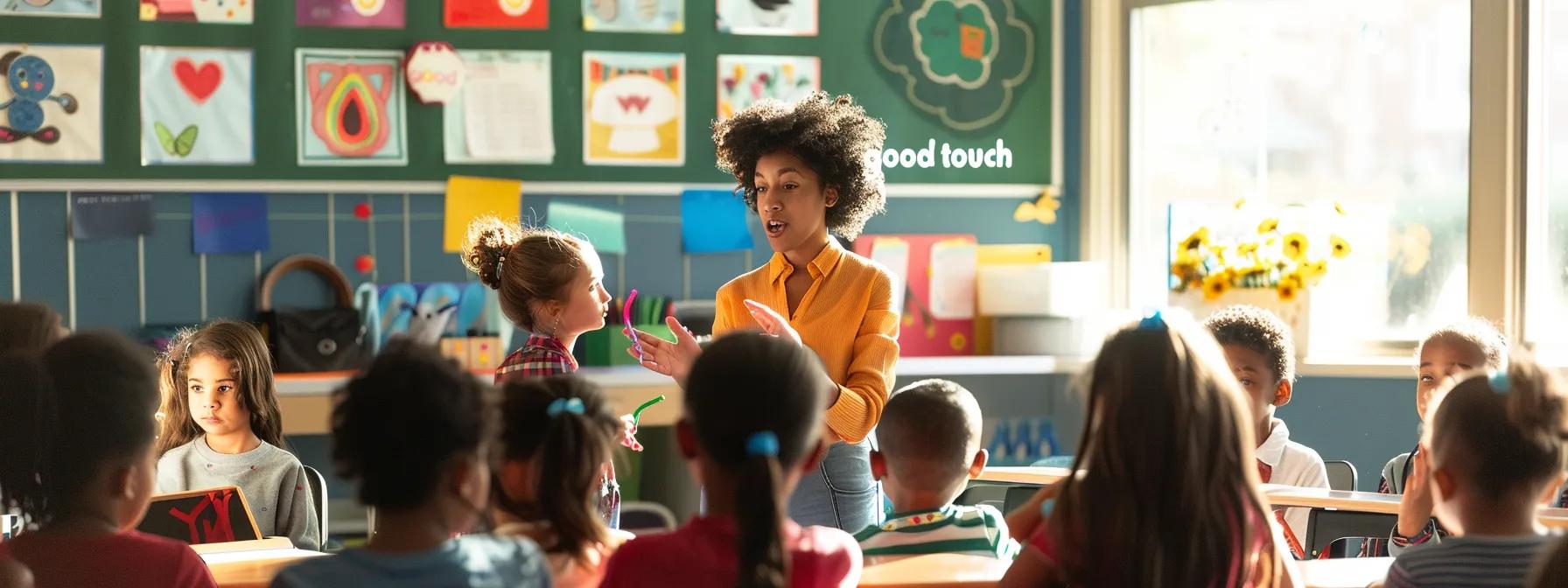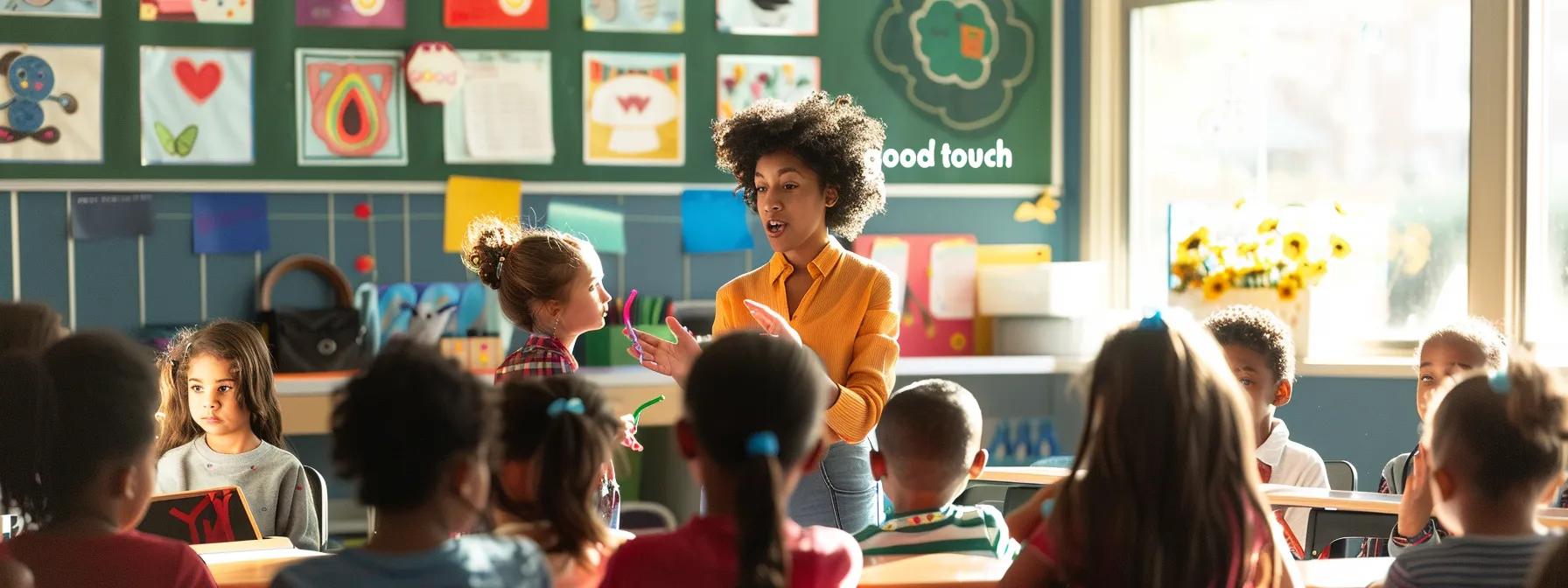
Teaching Your Child the Difference Between “Good Touch” and “Bad Touch” for Effective Child Safety Education

Teaching Your Child the Difference Between “Good Touch” and “Bad Touch” for Effective Child Safety Education
Learning to understand body safety is vital for children’s development. When parents, educators, and caregivers clearly explain “good touch” versus “bad touch,” children learn to protect themselves and build confidence. This article provides guidance on teaching body boundaries, understanding private parts, differentiating good and bad touch, recognizing signs of abuse, and responding appropriately. It also covers how to address online safety. With effective tools and strategies, caregivers can foster personal safety and support a child safety education curriculum.
In this article, we explore core concepts and actionable steps for teaching children about body safety. Without proper education on body boundaries, children may be vulnerable to abuse. The goal here is to empower caregivers with clear explanations, step-by-step procedures, and real-life examples that protect children physically, emotionally, and digitally.
Transitioning now to our detailed discussion, we first explore body boundaries and why they are important.
What Are Body Boundaries and Why Are They Important for Children?
Body boundaries are the physical and emotional limits that protect an individual’s personal space. Teaching children about these boundaries helps them distinguish between acceptable and inappropriate touch, fostering safety awareness and healthy social interactions. Establishing clear body boundaries early prevents confusion and reduces the risk of abuse. Children who understand their limits are more likely to assert themselves and report unsafe situations. Furthermore, learning personal boundaries builds confidence, improves social skills, and teaches respect for others’ privacy.
Parents should explain which areas of the body are private—typically those covered by underwear or a swimsuit—and discuss consent as a natural extension of body safety. With consistent supervision and open discussion, children learn that their bodies belong to them and that unwanted touch is never acceptable.
How Can You Explain Body Boundaries to Your Child?
Using simple, clear language is key. Parents can use everyday examples and storytelling to illustrate private areas. For instance, a hug from a parent is a “good touch” because it is caring and safe, while an unwelcome touch from another person is not acceptable. Phrases like “your private parts are the areas that only a trusted adult, like a doctor during a check-up with a parent, may touch” make concepts understandable.
Visual aids, role-playing games, and classroom activities such as drawing or labeling body parts further reinforce the concept. The message should always be positive: protecting one’s body is a way to care for oneself and to remain safe.
Which Body Parts Should Children Understand as Private?
Children should learn that the parts of their body covered by a swimsuit or underwear are private. Using simple anatomical terms, parents can explain that “private parts” include genital areas and other parts that are usually covered. This explanation should be clear and free of shame, ensuring that children feel respected rather than embarrassed.
For younger children, a simple rule like “if it’s covered by your swimsuit, it’s private” works well. As children grow older, more details may be introduced. It is also important to note that even seemingly “friendly” touches can cross personal boundaries if they make a child uncomfortable; in such cases, the child should be encouraged to say “no” and report the situation to a trusted adult.
How Does Teaching Consent Relate to Body Boundaries?
Consent is an essential part of understanding body boundaries. It means that any touch—whether a hug, kiss, or pat—should only occur when both parties agree. Children should learn that they have the right to say “yes” or “no” to any touch. Similarly, caregivers should ask for permission before giving physical affection. Teaching consent reinforces that a child’s comfort is a priority and helps them understand their own rights and responsibilities. This ongoing discussion also explains that feelings about touch can change over time and that it is always acceptable to update one’s boundaries.
How Do You Define Good Touch and Bad Touch for Kids?

Good touch is any physical contact that is caring, comforting, or necessary—such as a hug from a parent, a teacher’s pat on the back, or a gentle kiss on the forehead. Such touches convey love and safety. Bad touch, in contrast, is any contact that is unwanted, coercive, or abusive. It includes touches that occur in private areas without a proper reason or by someone who should not be touching the child. Children must be taught that if any touch makes them feel uneasy, they should immediately say “no” and tell a trusted adult. Empowering children to trust their instincts is a key element in preventing abuse.
What Are Clear Examples of Good Touch?
Examples of good touch include: • A warm embrace from a parent • A cuddle before bedtime • A gentle pat on the shoulder from a teacher • A friendly high-five during a game
These touches are delivered in appropriate settings and with care. Role-playing activities, where children practice asking permission before giving or receiving a hug, help reinforce that good touch is always consensual.
What Are Clear Examples of Bad Touch?
Bad touch is characterized by contact that is unwanted or makes the child feel uncomfortable. Examples include: • Touching private areas such as those covered by a swimsuit without a legitimate reason • Any touch that makes a child feel scared, embarrassed, or confused • Actions by an adult that breach a child’s personal space
If a child experiences such touch, they should understand that it is never their fault and that they have every right to seek help. Parents and caregivers must stress that discussing these experiences is important for their safety.
How Can You Explain Confusing or Mixed Touches to Children?
Sometimes, touch may feel ambiguous. Confusing or mixed touches are those that seem friendly but leave the child feeling unsure. It is important to teach children that if any touch—even one that seems well-intentioned—makes them feel puzzled or uncomfortable, they should speak up. For example, a pat on the back that feels too hard might be confusing. Parents should encourage children to express their feelings without fear of being wrong, emphasizing that it is always better to ask questions when something doesn’t feel right.
What Are the Signs That a Child May Have Experienced Bad Touch or Abuse?
Recognizing the signs of abuse is critical for timely intervention. Changes in behavior, such as withdrawal, increased anxiety, or sudden fear of certain people or places, can be indicators. Physical signs might include unexplained bruises or injuries in areas normally covered by clothing.
Many children do not express experiences of bad touch verbally but may show signs through regressive behaviors like bedwetting or thumb-sucking, or by becoming unusually quiet or aggressive. Even subtle changes in behavior or reluctance to participate in activities may signal that something is wrong. Early recognition is key to ensuring that appropriate help is provided.
Which Behavioral and Physical Signs Should Parents Watch For?
Parents should observe for: • Sudden withdrawal from social interactions or activities • Noticeable changes in academic or social performance • Unexplained bruises, redness, or scratches in normally covered areas • Sudden onset of bedwetting, thumb-sucking, or other regressive behaviors • A persistent sense of fear or anger around specific people or places
These signs, especially when they occur together, should prompt parents to seek professional advice.
How Can Children Express Concerns About Unsafe Touch?
Children may express their discomfort in various ways: • Verbal statements to a parent or teacher • Drawings or play that reflect their feelings • Nonverbal cues such as crying or sudden quietness
It is important that children know they have multiple avenues to communicate their feelings. Caregivers must encourage any expression of discomfort and respond without judgment, reinforcing that the child’s safety is paramount.
How Should Parents and Educators Respond When a Child Reports Bad Touch?

A measured, immediate response is critical when a child reports bad touch. The first step is to listen calmly and without judgment, assuring the child that they are not at fault. Documenting the child’s account and contacting appropriate authorities or child protective services is essential. Professionals, such as school counselors or pediatricians, should be involved as soon as possible to ensure the child's continued safety and emotional wellbeing.
This structured response helps minimize the potential long-term effects of abuse and reinforces trust between the child and the caregivers.
What Are the Immediate Steps to Take After Disclosure?
Upon disclosure, caregivers should: • Remain calm and provide immediate comfort • Validate the child's feelings without showing shock • Document every detail of what was shared • Inform a trusted authority such as a school official or child protective service • Reassure the child that appropriate steps are being taken to keep them safe
This approach ensures a safe environment and helps the child start the healing process.
Who Are Trusted Adults Children Can Turn To?
Trusted adults form a child’s safety net. They typically include: • Parents and grandparents • Teachers and school counselors • Close family friends, pediatricians, or religious leaders
These individuals must listen without judgment, maintain confidentiality, and act in the child's best interests. In environments like classrooms or daycare, a consistent, approachable presence can encourage children to report concerns promptly.
How Can You Support a Child Emotionally After Disclosure?
Emotional support is paramount after disclosure. Caregivers should: • Listen empathetically and validate the child's feelings using reflective language • Reassure the child that the abuse is not their fault • Arrange for professional therapy or counseling as needed • Engage the child in stress-relieving and fun activities to help rebuild confidence • Maintain open communication during the healing process
A gentle, patient approach helps the child slowly regain emotional stability and trust.
How Can You Teach Children About Online Safety Related to Touch and Boundaries?
In the digital age, online safety is as crucial as in-person safety. Children use various platforms where online grooming and unsolicited contact can occur. It is essential to extend discussions about touch and boundaries to include digital interactions. Caregivers should teach what constitutes appropriate online behavior and how digital actions have lasting effects.
A proactive strategy involves explaining online grooming – when predators build trust with the intent to exploit – and setting clear rules about sharing personal information. Children should know never to share private details or images online and to immediately tell a trusted adult if something feels off.
What Is Online Grooming and How Can Children Recognize It?
Online grooming involves an adult gradually building an emotional connection with a child to exploit them. Warning signs include: • Requests for private conversations away from monitored platforms • Invitations for video calls that feel uncomfortable • Discussions that seem too mature or push personal boundaries
Through role-playing and clear guidelines, children can learn to reject such advances and report suspicious behavior.
How Can Safe Online Communication Be Encouraged?
Safe online communication can be promoted by: • Teaching children not to share personal details such as their full name, address, or school • Explaining digital footprints and the permanence of online actions • Establishing rules to only interact on approved platforms with parental consent • Using parental controls to ensure a secure online environment
These practices help children apply the same principles of personal safety they learn offline to their digital interactions.
What Tools Help Protect Children in Online Environments?
Several tools can enhance online safety: • Parental control software that monitors web access and restricts inappropriate content • Secure browsers and safe search tools • Apps for monitoring social media interactions and messaging
Such tools, combined with ongoing parent-led discussions about digital behavior, create a vigilant and secure online experience for children.
What Resources Are Available for Parents and Educators to Teach Good Touch and Bad Touch?

A wealth of resources is available to help teach children about body safety. These include: • Lesson plans and interactive activities designed for various age groups • Books and videos that explain concepts using simple language and engaging visuals • Webinars and teacher training seminars for ongoing professional development • Online platforms that offer digital storytelling, quizzes, and printable materials
These resources ensure that educational content remains current, engaging, and effective in reinforcing the lessons of good touch and bad touch.
Which Lesson Plans and Activities Are Effective for Different Age Groups?
Effective lesson plans vary by age: • For preschoolers: Interactive storytelling, puppetry, and coloring activities introduce body boundaries. • For kindergarteners: Drawing “body maps” and simple role-playing exercises reinforce identifying private parts. • For school-aged children: Role-playing, quizzes, and small group discussions help articulate consent and express discomfort. • For preteens and adolescents: Group projects, case studies, and workshops on advanced topics like peer pressure and digital safety foster critical thinking.
A sample table of lesson plans can guide educators in selecting age-appropriate activities to reinforce body safety principles.
What Books, Videos, and Interactive Tools Help Reinforce Safety Lessons?
Books and videos are excellent for reinforcing body safety: • Picture books with friendly characters and simple language help younger children grasp key concepts. • Animated series and videos provide visual reinforcement of positive touch and safe behaviors. • Interactive apps and online tools with quizzes and games offer engaging ways for children to learn and practice safety skills.
These multi-sensory approaches cater to different learning styles, reinforcing key messages in a variety of formats.
Where Can You Find Support Organizations and Professional Help?
Parents and educators can access additional support through: • National and local child protection agencies offering guidelines and hotlines • Nonprofit organizations that provide free training seminars, webinars, and printed materials • Professional associations for educators that host conferences and workshops
Staying connected through newsletters and online communities also helps continuously update teaching methods and maintain a safe educational environment.
What Are Common Questions Parents Have About Teaching Good Touch and Bad Touch?
Parents often have questions about how best to address touch safety with their children. Concerns range from how to start conversations to recognizing signs of distress and maintaining ongoing dialogue. Clear, factual answers help demystify the topic and encourage proactive involvement.
Common queries include ways to adapt discussions to different age levels, balancing protection with freedom, and handling inconsistent messages from peers or media. Providing published research, expert recommendations, and practical toolkits can build confidence among caregivers.
How Do You Start the Conversation About Touch Safety With Your Child?
Experts recommend that conversations about touch safety begin during everyday interactions rather than after a crisis. Simple discussions during routine activities—like bath time or car rides—can introduce the topic gently. Using clear examples of safe touch, contrasting them with confusing or inappropriate contacts, and employing age-appropriate language helps set a strong foundation.
How Can You Maintain Ongoing Dialogue About Body Safety?
Maintaining dialogue means incorporating regular check-ins and discussions into daily life. This can include: • Scheduled family meetings or classroom sessions focused on body safety • Interactive activities that encourage ongoing questions • Periodic reviews of rules and boundaries as children grow
Continual conversation helps children internalize that their safety is a lifelong priority.
What Are the Best Practices to Empower Children Without Causing Fear?
To empower children without instilling fear, caregivers should: • Use clear, non-alarmist language • Provide practical, relatable examples • Engage in role-playing exercises that simulate safe scenarios • Reassure children that they have control over their own bodies and that trusted adults are always available to help
This balanced approach builds confidence and essential self-advocacy skills.
Frequently Asked Questions
Q: At what age should parents start discussing body boundaries with their children? A: Parents are encouraged to begin simple conversations about body boundaries during early childhood, around preschool age, using clear language and visuals. As children grow, ongoing age-appropriate discussions help reinforce these concepts.
Q: How can parents ensure that children understand the concept of consent? A: By illustrating that any friendly touch should be agreed upon by both parties—through role-playing and everyday interactions like asking before hugging—children learn that they have the right to decide and express their feelings.
Q: What should a parent do if a child shows signs of trauma after disclosing a bad touch? A: Respond calmly and empathetically, provide a safe environment, document the child’s concerns, and seek professional help from a counselor or pediatrician. In some cases, involving child protective services is necessary.
Q: Can digital tools and apps really help in teaching children about online safety? A: Yes. Many digital tools and apps offer interactive, engaging lessons in online safety, including games, quizzes, and guided sessions that reinforce what constitutes good and bad touch in both physical and digital environments.
Q: How can educators integrate body safety lessons into their existing curriculum? A: By incorporating interactive methods such as storytelling, role-playing, and multimedia presentations, educators can seamlessly weave body safety lessons into subjects such as social studies or health education.
Q: Are there specific signs that indicate a child might be experiencing abuse related to touch? A: Yes. Indicators include behavioral changes like withdrawal, sudden fear or aggression, regressive behaviors, and unexplained physical marks such as bruises. Close monitoring by parents and teachers is essential.
Q: How can parents maintain open communication about sensitive topics like touch safety over time? A: Consistent, calm, judgment-free conversations paired with regular check-ins and updated materials help maintain open dialogue as children grow and encounter new experiences.
Final Thoughts
The education of children regarding good touch and bad touch is essential for building lifelong personal safety, self-esteem, and healthy relationships. By establishing clear body boundaries and maintaining open communication, parents and educators create a secure environment where children feel empowered. This comprehensive approach—including digital safety and ongoing dialogue—ensures that lessons on personal boundaries remain effective over time, fostering resilience, trust, and the confidence to navigate both physical and digital spaces.